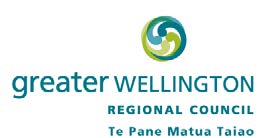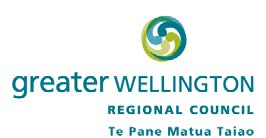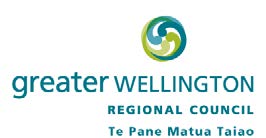
 By email
By email
Shed 39, 2 Fryatt Quay
Pipitea, Wellington 6011
PO Box 11646
26 March 2020
Manners Street
Wel ington 6142
T 04 384 5708
File Ref: OIAP-7-14125
F 04 385 6960
www.gw.govt.nz
Michael Brown
[FYI request #12336 email]
Dear Mr Brown
Request for information 2020-036
I refer to your request for information dated 1 March 2020, which was received by Greater Wellington
Regional Council (GWRC) on 1 March 2020. You have requested the following information:
“Metlink currently provides information about punctuality on the train network in this form
on its website : "The rail punctuality measure records the percentage of services arriving at
key interchange stations and final destination within five minutes of the scheduled time"
(https://www.metlink.org.nz/our-metlink-bus-journey/performance-of-our-
network/#DataAndReports).
However, recording the percentage of services which are punctual - and by implication, late
- gives an ambiguous picture on how lateness is actually impacting upon the passenger base.
A better way of measuring this impact would be to weight the punctuality data using the
number of passengers on particular services. Thus, if a train is late during an off-peak trip,
when passenger numbers are likely to be low, the impact is relatively small. But if a train is
late on a peak service, then the impact is much greater. If such a weighted analysis was made
of all late services, then a clearer overall picture of the impact of lateness would emerge than
what is suggested by the information currently provided to the public (e.g. 88.4% of services
were on time on HVL during November 2019).
Here are my requests for information:
1. Does the WRC/Metlink already perform any weighted analyses of train punctuality in the
way - more or less - described above?
2. If so, please provide a summary of what information and reports it holds.
3. If not, can you please advise if you would be able to undertake this analysis using the data
you already hold (i.e. for every service, both passenger numbers and punctuality data) for the
 purpose of this OIA. As I realise this might take some time, only a sample experiment would
purpose of this OIA. As I realise this might take some time, only a sample experiment would
be necessary: services on the Hutt Valley Line for November 2019.
4. If you do hold the data, but are unable to accommodate my request, could you please supply
the raw data for all services on the Hutt Valley Line for November 2019, as well as information
on how the data is gathered. It would be most useful if the data was in the form of an Excel
spreadsheet.”
GWRC’s response follows
Weighting of rail Punctuality data by passenger loadings on particular services
While GWRC does not measure or quantify the ‘passenger impact’ of late-running services by cross-
referencing overall service performance data with passenger loadings per trip as you describe. We do
collect rail peak performance statistics for select services.
The analyses are weighted in the sense that we only focus on the busiest morning and afternoon
services. In the morning peak period we focus on the busiest inbound services carrying commuters
south (excluding the northbound trips that carry significantly fewer passengers). The same principle
applies for the afternoon peak period, where we focus on the busiest outbound services returning
commuters home but exclude the southbound services.
Peak performance for punctuality and reliability is reported on daily, weekly and monthly. This
alongside overall performance figures are used to monitor ongoing performance of all rail services.
These statistics form the basis for measuring performance improvement over time.
Please note that the general Metlink definition of ‘peak’ refers to a non-contiguous time period in
effect before 9am, and again between 3pm and 6:30pm, on weekdays (‘off-peak’ times are in effect
at all other times, including weekends). However, as it pertains to rail service performance
measurement, we have a separate usage of the term
Peak as follows:
Peak Service
means a Scheduled Service which:
(a) in the case of a Train travelling towards Wellington Station, is
scheduled in the Rail Unit Timetable to arrive at its Destination
between 06:30 and 09:30 on a Business Day; and
(b) in the case of a Train travelling away from Wellington Station, is
scheduled in the Rail Unit Timetable to depart Wel ington Station
between 15:30 and 18:30 on a Business Day.
By these measures, for the month of January 2020 overall rail punctuality was 91% but peak
punctuality was 83.4%.
PAGE 2 OF 4

We also collect rail patronage data, which for reporting purposes is aggregated per rail line and across
all rail lines. On-board rail staff record a service high count to capture the maximum amount of
passengers on board each service. Generally this occurs outside Wellington Station. As part of formal
patronage reporting, a multiplier is applied to the passenger high count to account for passengers who
get on and off services during the journey. As counts are collected manually by on-board rail staff,
and do not take place at every station, they are subject to an operational margin of error.
Data availability
The following rail patronage data and overall rail performance statistics are available: on the Metlink
website.
• Annual patronage across all rail lines, differentiated by peak and off-peak periods (note the
service performance definition of
Peak as noted above), can be found in the ‘Network
patronage for bus, rail & ferry’ section of:
https://www.metlink.org.nz/our-metlink-bus-
journey/performance-of-our-network/#DataAndReports .
• Monthly peak patronage per rail line is also available in the ‘Metlink Monthly Performance
Reports’ section of the same page.
• Overall rail performance statistics (for all services) are available on the Metlink website at:
https://www.metlink.org.nz/our-metlink-bus-journey/performance-of-our-network see data
and reports.
Punctuality and passenger loadings data for Hutt Valley line services, November 2019
Please also find attached (Attachment 1), performance commentary and patronage data for all Hutt
Valley line services that operated over the month of November 2019, as suggested in your request at
point “4”. Please note the following:
• Values in the
Journey ID column represent the unique identifying code of each HVL trip.
• Both peak and off-peak trips have been included in the data; however, you may use the filter
to display only
Peak trips if you wish. As earlier, the service performance definition of
Peak
pertains.
•
Inbound services are heading southbound towards Wellington;
Outbound services are
heading northbound towards Waterloo or Upper Hutt. For weighting purposes, this would
make Inbound the relevant direction for morning peak trips and Outbound the relevant
direction for afternoon peak trips.
• Values in the
Comment section indicate the Punctuality of each service, in the time groupings
used for general reporting purposes:
o On-Time (indicates departure between 1 minute earlier than to 5 minutes later than the
scheduled departure time from origin station);
PAGE 3 OF 4


o 5 to 7 minutes late;
o 7 to 15 minutes late;
o 15+ minutes late;
o Bus replaced;
o Cancelled.
• Values in the
Patronage column represent passenger numbers on that service, subject to the
modifier accounting for mid-journey boardings and alightings as described above.
I hope that you will find this information useful.
If you have any concerns with the decision(s) referred to in this letter, you have the right to request
an investigation and review by the Ombudsman under section 27(3) of the Local Government
Official Information and Meetings Act 1987.
Yours sincerely
Scott Gallacher
General Manager, Public Transport
PAGE 4 OF 4





